Introduction
Ornamental plant retailers face multiple challenges, including identifying their market, analyzing their current and potential consumer base, determining prices, and developing promotional programs to attract new customers. Previous research (Irani et al. 2011; Yue and Behe 2008) has focused on investigating consumer demographic profiles as well as consumers' store choices and their preferences for ornamental plant attributes, such as colors and scents. Research investigating consumption patterns such as seasonal and occasional purchases, repeat-buying habits, and purchase frequency has also benefited the industry by providing useful insights for developing effective marketing strategies. Research in other industries shows that consumers react to incentives, such as relevance and benefits of products and services provided. For example, the food industry is active in promoting the nutritional benefits of their products through various marketing channels, such as labels and advertisement. Research studies found that the effectiveness of these strategies was significant (Kiesel and Villas-Boas 2010; Vande Kamp and Kaiser 1999).
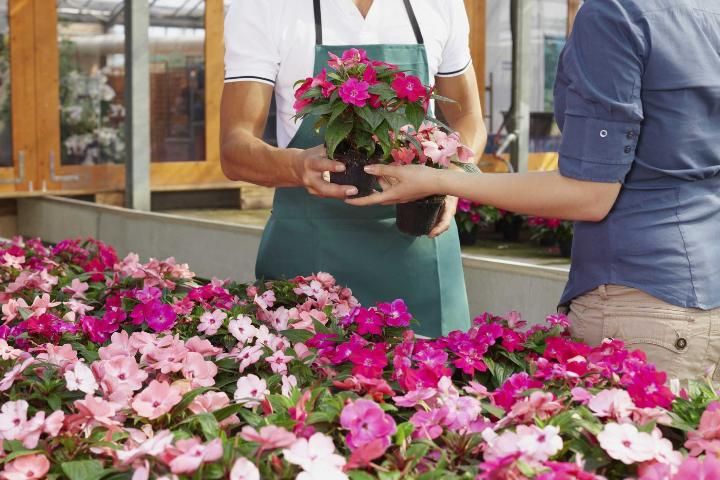
Credit: diego_cervo/iStock/Thinkstock, © diego_cervo
Horticultural products, too, can provide many benefits to human life. For instance, research literature showed that being around plants helps improve concentration, boosts creativity, and accelerates the healing process. In addition, plants surrounding buildings help save energy by reducing the sun's radiation effect on the buildings (Hall and Dickson 2011). Nevertheless, compared with traditional agricultural industries, the environmental horticultural industry is less aggressive in promoting the benefits of its products. Managers at nurseries and garden centers, for instance, are less likely than managers of grocery stores to promote information about the benefits their products can provide to consumers.
The primary goal of this study is to assist industry participants by providing information about consumer purchasing preferences, including information about past and future expenditures on ornamental plants, plant-specific and store-specific factors that influence purchase decisions. Additionally, the study sought to determine whether providing consumers with information about the health and well-being, environmental, and economic benefits of ornamental plants had any effects on consumer preferences for ornamental plants.
Summary of Survey Results
Survey Sample
A nationwide internet survey was conducted in the spring of 2012 through both Qualtrics and Global Market Insite (Internet survey service companies). The survey questionnaire was distributed to 2,198 randomly selected panelists, of which 1,982 panelists agreed to participate in the plant purchasing preferences survey. Questionnaires with the majority of the questions left unanswered were considered incomplete and were excluded from further analysis. After inspecting the data for missing answers, 1,151 respondents were selected for further analysis. According to the survey results, the typical ornamental plant purchaser is an individual who resides in a suburban area, lives in a single-family-owned home valued between $100K and $200K, works more than 40 hours a week at a job, and has at least some college education. It is notable that individuals in the 50–59 and 60–69 age groups (9.4% of the US population) are more likely to be potential plant purchasers than consumers in other age groups.
Household Expenditures on Ornamental Plants
Among the 1,151 panelists who indicated a willingness to buy ornamental plants over the next 12 months, 79.1% had purchased ornamental plants in the last year, while 20.9% had not. The amounts they had spent in the last year were relatively evenly distributed. The proportion of respondents who spent $1–$25, $26–$50, or $51–$100 on plants were 19.9%, 20%, and 19.98%, respectively (Figure 1). In contrast, only 12.7% and 6.7% of the respondents reported relatively higher expenditures, $101–$200 and over $200, respectively.
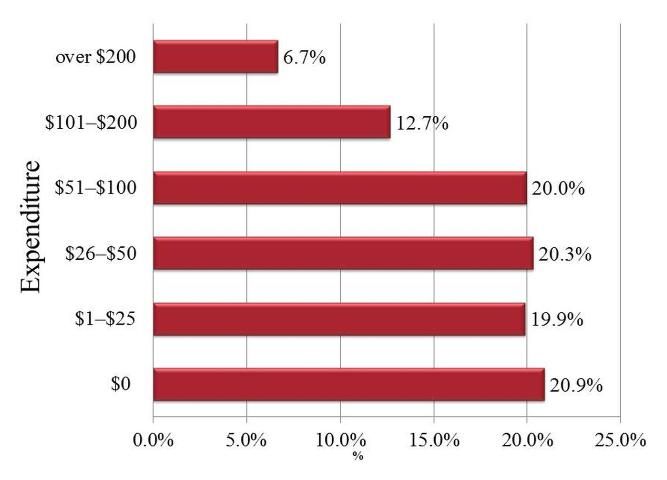
The results also showed that expected future sales are more likely to occur with existing consumers. Thirty-four percent of respondents owned 15 plants or more, 12.3% owned 11–15 plants, 19.6% owned 6–10 plants, 27% owned at least one plant, and 7% did not own any plants (Figure 2). Only a small portion of the potential buyers were new customers. This finding suggests the difficulty in attracting new consumers into this market, since most of the plant purchasers were recurring customers.
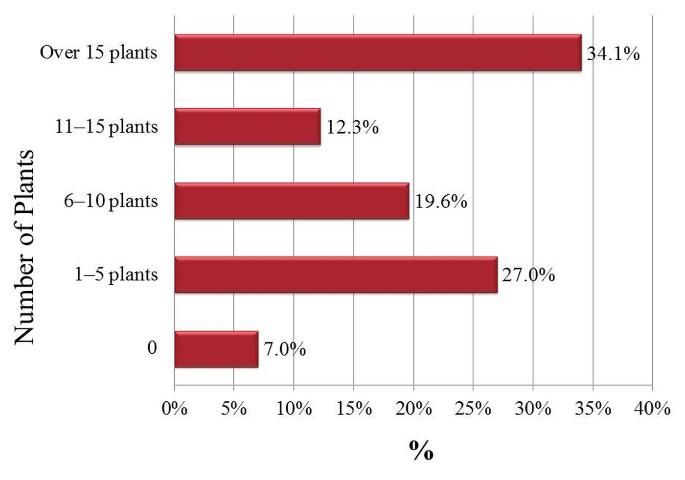
Household income was positively correlated with ornamental plant expenditures planned for the next 12 months. The highest amount ($139.40) was reported by respondents with annual household incomes between $180K and $200K (Figure 3). The lowest amount ($32.70) was reported by respondents with household income less than $20K. While the majority of consumers with household incomes over $120K were estimated to spend more than $50 a year, the majority of consumers with household incomes under $120K were estimated to spend less than $50. Expected expenditures by education level, age, and residence-type were also analyzed (see the main report).
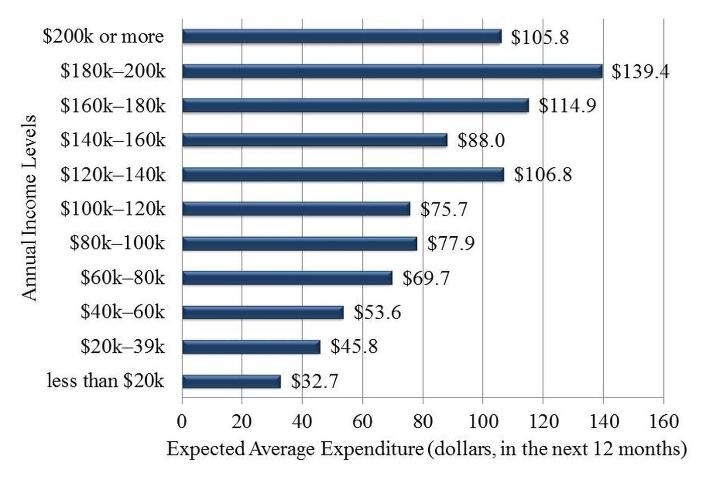
Factors Influencing Plant and Store Choices
Respondents were asked to indicate the type of store where they purchase their ornamental plants and to rank the factors that influence their store choice decisions (Figure 4). Of the surveyed respondents, only about one-third (33%) indicated that they usually purchase ornamental plants at local garden centers. Other places where ornamental plants were purchased included home improvement or hardware stores (35.6%), supermarkets and grocery stores (14.7%), farmer's markets (9.6%), and online purchases (3.5%).
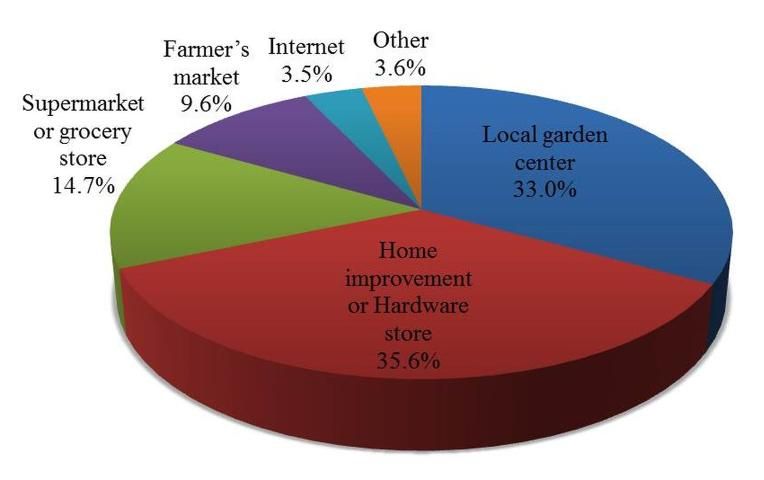
Slightly over 20% of the respondents indicated that plant selection was an important factor in their store choice. Store prices were ranked second, with 20.1% of the respondents indicating that prices influenced their store choice decision. Plant quality was ranked the third most important factor (19.9%), followed by convenient location (13.9%) and knowledgeable staff (8.9%). Factors such as one-stop shopping (5.6%), customer service (4.5%), and hours of operation (3.8%) were ranked relatively less important. The least important factors influencing consumers' choice of an outlet for plant shopping were advertisements (1.4%) and friends' referrals (1.6%) (Figure 5).
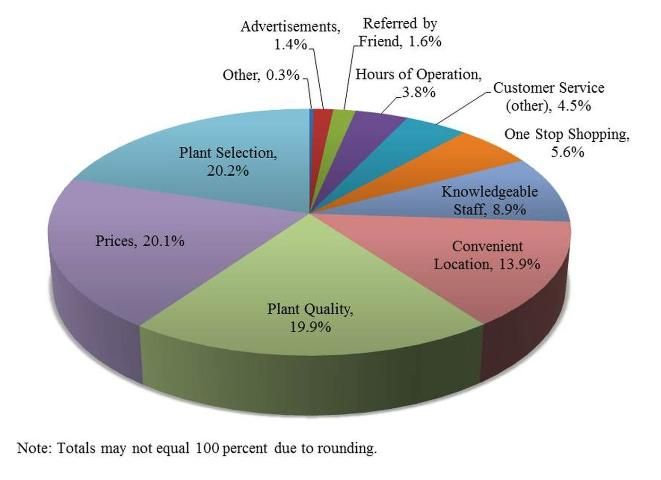
Consumers chose plant quality as the most important factor when purchasing plants (47.5% very important, and 45.1% extremely important) and price and plant color as the second and third most important factors, respectively. The averages of lighting demand, drought tolerance, flowering, size of plant, and guaranteed growth scored between neutral and very important. The function of plants as air purifiers is not considered an important factor based on its mean score of 2.9, with 45.5% of respondents mentioning air purification as neither important nor unimportant. The lack of perceived importance in air purification and in color and flowering suggest that consumers mainly choose plants for their ornamental function, or that they are unaware of plants' ability to clean the air.
More than 48% of the survey respondents were interested in buying perennials, compared to 26.6% and 22.9% of respondents interested in annual and foliage plants, respectively. The flowering characteristic scored as an important factor when consumers make plant purchasing decisions, with more than 70% of respondents preferring flowering plants to foliage.
Benefit Information Effectiveness
Part of the questionnaire was designed to examine how learning about the benefits of plants might affect consumer preferences and demand for ornamental plants (Figure 6). Among the numerous benefits that plants may provide to humans, the following three categories were selected for the questionnaire: (1) health/well-being benefits (e.g., healing effect, mental health, air purification), (2) economic benefits (e.g., enhanced real estate value, curb appeal, etc.), and (3) environmental benefits (e.g., clear air, reduced noise pollution, cooling effects, etc.). The survey respondents read one-page explanations for each type of benefit that plants provide to humans and/or the environment. After each benefit's information was provided, the respondents were asked (1) whether the information was useful to understand the benefits of ornamental plants, and (2) whether the information was effective enough to influence their preferences and to encourage them to purchase more plants in the future.
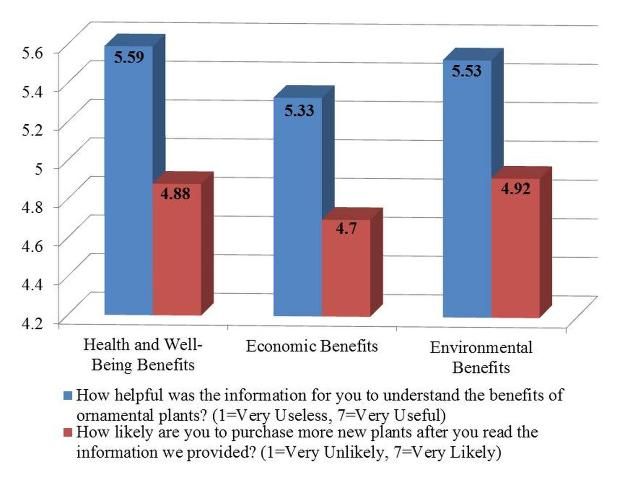
The majority of the survey respondents indicated that the health/well-being benefit information provided in the survey was either useful (33.5%) or very useful (23.2%) for understanding the benefits that plants can bring to human life. Less than one-third of the respondents (28.1%) indicated that the information was somewhat useful, 11.2% of the surveyed individuals stayed neutral, and only a small portion of the participants expressed the opinion that the information was somewhat useless (1.7%), useless (1.0%), or very useless (0.9%).
Less than one-third (32.4%) of the participants indicated that they were likely (17.6%) or very likely (14.8%) to purchase more new plants in the near future, while 24.9% were undecided, and over one-third (42.5%) indicated that they were somewhat likely (29.5%), somewhat unlikely (7.3%), unlikely (3.4%), or very unlikely (2.3%) to purchase more plants.
More than half of the survey participants perceived environmental incentives as useful (31.4%) and very useful (22.6%). While economic benefits related information was found to be useful for about 46% of the participants, environmental incentives were found to be considerably more useful (54%) in helping respondents understand the benefits that plants can bring in everyday life. The usefulness of environmental and economic benefits, however, does not translate into the likelihood of increasing plant purchases in the future. A relatively smaller portion of respondents indicated that they would increase their plant purchases (i.e., 16.4% chose very likely and 19.0% chose likely for environmental benefits information, while 13.3% chose very likely and 16.3% chose likely for economic benefits information).
Conclusions
This article summarizes results from a national consumer survey that was conducted to investigate consumer purchase preferences, including information about their past and future expenditures on ornamental plants, plant- and store-related factors that influence purchase decisions, and a standard set of socio-demographic variables. The survey also investigated the effectiveness of health/well-being, environmental, and economic benefits information to stimulate future purchases of ornamental plants. The quality of plants and prices are ranked as the most important factors in consumers' decisions of plant purchases, followed by color. It is notable that color and flowering characteristics are considered more important than the ease of care and air purification functions. This suggests that consumers mostly enjoy the beauty that plants provide, rather than any other benefits they may provide, such as clean air. These findings can be applied to developing targeted marketing strategies for consumer groups with different demographic and preference categories. For example, to stimulate repeat consumer sales, marketing strategy should focus on developing new varieties of colors and flowers. Better communication about the benefits that ornamental plants provide to humans may also be useful in attracting new consumers.
References
Hall C. and M. Dickson. 2011. "Economic, environmental, and health/well-being benefits associated with green industry products and services: A review." Journal of Environmental Horticulture 29: 96–103.
Irani, T.A., D. Clark, B. Raulerson, and D. Slough. 2011. Not Your Grandmother's Flowers: What Combination of Flower Fragrance and Color Is Preferred by Young Adult Consumers? Special Research Report #709, American Floral Endowment, Alexandria, VA. http://endowment.org/wp-content/uploads/2014/03/709publicbenefitsreport.pdf
Kiesel, K. and S. Villas-Boas. 2010. "Can information costs affect consumer choice? Nutritional labels in a supermarket experiment." International Journal of Industrial Organization. http://www.csus.edu/indiv/k/kieselk/Nutritional%20label%20experiment_IJIO.pdf
Vande Kamp, P.R. and H.M. Kaiser. 1999. "Irreversibility in advertising-demand response functions: An application to milk." American Journal of Agricultural Economics 81: 385–396.
Yue, C. and B.K. Behe. 2008. "Estimating US consumer's choice of floral retail outlets." Hortscience 43: 764–769.